
21 minute read
Industry News
Car space by day, pop-up park by night
As public space becomes premium in our cities, could boutique sidewalk activations known as parklets be the solution?
Advertisement
Pop-up parks or parklets are mobile temporary sidewalk extensions which swap a parking space with a parking space-sized park. Rising to prominence in the streets of San Francisco in the early 2000s, they've since popped up in streets all around the world and could be on their way to your local suburb.
Dr Mike Harris, UNSW Built Environment landscape architect and urban designer, says that parklets are an example of the innovative ways streets could capitalise on underutilised space.
"What parklets do is activate a social space in a street that potentially doesn't have any," he says.
"With more people in our cities we need to be smarter with our public space, and on-street car parking is an obvious, if sometimes sensitive, opportunity. The amount of car parking on our high streets, at the sake of other uses, doesn’t really stack up economically, socially, or environmentally.” A simple parklet may provide seating, plants and shade to passers-by to relax and enjoy the atmosphere of their surroundings. "They're usually quite a simple setup; some seats, planter boxes and sometimes shade on a platform that extends from the footpath," Dr Harris says.
Public verandas, performance venues, workshop spaces, podcast studios and libraries, are among the more expansive car space turned park designs to date.
Maintenance Challenge for Road Delineators in Express Lanes in Highways
"Because car spaces are essentially temporary storage modules, you can simply plug in a public space… which will benefit more people than the single car space," he says. “In this way you could say parklets return public space to the public.”
He says that because parklets tend to be temporary or seasonal, "things can always return to normal relatively quickly if needed". "People don't really complain if it's just one spot," he says.
According to Dr Harris, parklets could be a rare 'win-win' for councils, satisfying both local businesses and residents.
"Councils may take a liking to them because they're quite novel, as an installation, they get an immediate response and get noticed by locals, and they can be seen to be taking an active role in the community." "Putting a new public space in front of a café for example, they become a big beneficiary because you attract people to that location and effectively give the café new spill-out space. This can inject a new type of social activity into the street, and then it can snowball with increased foot traffic into a more popular street in general."
There have been small pockets of street activation experimentation in Australia, notably with Sydney's Waverley and Randwick councils. The inner-city suburb of Glebe has also hosted trailer parklets, which were crowdfunded by the community, local businesses and the City of Sydney.
He says that while most are council led, there is potential for the community to play a more active role.
"They could be more locally-led, and locals could engage in discussions with the council. We see that from bottom-up policies that have recently been implemented like verge gardens," he says. Ennomotive, the leading open innovation platform for engineering challenges, just launched a competition to find an efficient solution to improve the cleaning and replacement process of road delineators in highways.
Cintra, with Ferrovial Agroman as the main constructor, has improved Interstate 77 in northern Charlotte, North Carolina, by adding electronic-tolled Managed Lanes along 26 miles of the highway. Once construction is finished, I-77 Mobility Partners (I-77 MP), a consortium led by Cintra, will be responsible for the operation and maintenance of the project.
The I-77 Express Lanes run adjacent to the existing general-purpose free lanes, separated by plastic delineators, whose main purpose is to prevent toll violators to enter or exit the toll lane without crossing a toll gantry. As established in the Concession Agreement, delineators must be cleaned to meet the reflectivity requirements and be replaced when damaged or missing. Consequently, Cintra is looking for solutions to reduce the maintenance cost of the delineators while complying with the contract requirements.
This online competition is open worldwide to any professional, company, or tech centre from different industries and technical backgrounds that want to propose a solution for this challenge.
Ennomotive offers AUD$27,500 in prizes to be shared among the best ideas for this competition. Interested participants should sign up at www.ennomotive.com and submit their solution before the 6th of April.

Researchers uncover significant malware campaign against Australian transportation sector
Mimecast Limited, a leading email and data security company, recently announced the availability of the Mimecast® Threat Intelligence Report: RSA® Conference Edition – which shows researchers uncovered, for the first time, a significant malware campaign against Australia’s transportation, storage and delivery sector.
The sector was targeted over 4 days between 22-25 October, 2019 by a campaign that used masses of Emotet – a malware strain that was deemed one of the most prevalent threats of 2019 and identified as a key threat by the Australian Cyber Security Centre (ACSC) on October 24, 2019. Globally, transportation, storage and delivery was the highest-attacked sector in 2019. With Australia becoming a key investment area for Chinese businesses, the volume and complexity of threats and attacks

against the local industry are likely to increase. The full report is available for download at: www.mimecast.com/globalassets/ documents/whitepapers/threat_ intelligence_report_rsa-2020.pdf
Seismic Shaking up compaction

THE BEAT OF A DIFFERENT DRUM Dynapacs Seismic system recognises all drum and soil combinations and automatically detects the frequency of the soil characteristics. Working together with it, and applying the correct amount of energy when required. Ensuring optimal compaction everytime.
Infrastructure can lay the foundations for Australia’s net zero emissions future
Infrastructure will play a critical role in supporting Australia’s transition to net zero emissions according to a new paper released recently.
Infrastructure contributes around 70 per cent of Australia’s annual greenhouse gas emissions, according to the Issues Paper: Reshaping Infrastructure for a net zero emissions future. The paper is published in partnership by the Infrastructure Sustainability Council of Australia (ISCA), ClimateWorks Australia and the Australian Sustainable Built Environment Council (ASBEC).
“Most infrastructure built today will still be operating in 2050,” says Ainsley Simpson, CEO of ISCA. “By this point, all Australian states and territories are aiming to be at net zero emissions.”
Ms. Simpson says that infrastructure must respond to and support broader economic and social trends, one of which is decarbonisation of Australia’s economy.
“Infrastructure is facing pressure from both the public and private sector to prepare for net zero emissions,” said Ms Simpson.
“In addition to state and territory commitments, private investors are increasingly aligning their portfolios with net zero emissions.” Mr Michael Li, Senior Project Manager (Cities & Policy), at ClimateWorks Australia, says infrastructure influences 15 per cent of Australia's emissions directly and 55 per cent indirectly.
"Direct emissions occur across the life-cycle including in procurement, construction, operations and decommissioning. But the majority of emissions are associated with the end use of assets and the activities they enable," said Mr Li.
“For example, providing public transport infrastructure close to population centres can reduce local road transport emissions,” he said. Ms Suzanne Toumbourou, Executive Director of ASBEC, says that preparing infrastructure for a net zero emissions future is a shared responsibility between all stakeholders across the infrastructure lifecycle, including infrastructure advisors, investors, construction companies and operators.
“With billions of dollars in the infrastructure pipeline, and the need to rapidly rebuild infrastructure after this summer’s natural disasters, now is the time for consensus about what role infrastructure can play in achieving a net zero emissions future,” said Ms Toumbourou.
The Issues Paper will be a focal point for conversations amongst infrastructure stakeholders around reshaping the conception, planning, design, construction and operation of infrastructure for a net zero emissions future. Using the Issues Paper as a starting point, ISCA, ClimateWorks and ASBEC aim to work collaboratively with those responsible for planning, assessing, funding and delivering infrastructure. ISCA, ClimateWorks and ASBEC will be actively engaging with infrastructure sector individuals and organisations and inviting them to this important conversation.
“We invite stakeholders from across the infrastructure sector to collaborate and participate in solutions-focused discussions that are essential to reshaping infrastructure for a net zero emissions future,” says Ms. Simpson.
Stakeholders who wish to participate in the conversation throughout 2020 and beyond are also invited to reach out directly to ISCA, ClimateWorks and ASBEC for updates.
Reshaping Infrastructure for a Net Zero Emissions Future is a partnership between ISCA, ClimateWorks Australia and ASBEC. For more information, or to download a copy of the paper, visit: www. isca.org.au
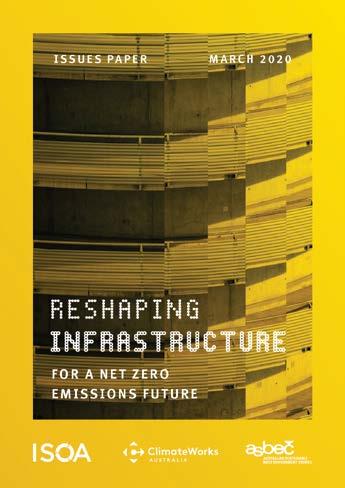
ABOUT ISCA The Infrastructure Sustainability Council of Australia (ISCA) is a member-based, not-for-profit peak body operating in Australia and New Zealand with the purpose of enabling and rewarding sustainability best practice in infrastructure. It does this through: • Operating an Infrastructure Sustainability (IS) rating scheme for infrastructure assets • Delivering training and capacity-building to enhance sustainability in infrastructure • Connecting infrastructure projects to suppliers of sustainable products and services • Bringing sustainability practitioners and infrastructure professionals together • Recognising and rewarding best practice in sustainability and resilience
CLIMATEWORKS AUSTRALIA ClimateWorks Australia develops expert, independent and practical solutions to assist in the transition to net zero emissions for Australia, Southeast Asia and the Pacific. Co-founded by The Myer Foundation and Monash University in 2009, ClimateWorks is a non-profit organisation working within the Monash Sustainable Development Institute. ClimateWorks also benefits from strong relationships with an international network of affiliated organisations that support effective policies, financing and action for emissions reductions. Acting as a bridge between research and action, the ClimateWorks collaborative end-to-end approach seeks solutions that will deliver real impact. ClimateWorks supports decision-makers with tailored information and tools, working with key stakeholders to remove obstacles and help facilitate conditions that support the transition to a prosperous, net zero emissions future.
ABOUT ASBEC The Australian Sustainable Built Environment Council (ASBEC) is the peak body of key organisations committed to a sustainable built environment in Australia. ASBEC members consist of industry and professional associations, non-government organisations, and government and academic observers who are involved in the planning, design, delivery and operation of Australia’s built environment. ASBEC provides a collaborative forum for organisations which champion a vision of sustainable, productive and resilient buildings, communities and cities in Australia.
Contractors keen to get started on NZ Upgrade Programme New Zealand’s civil contractors have welcomed New Zealand Government’s recent announcement of a range of infrastructure projects funded under the New Zealand Upgrade Programme.
Civil Contractors New Zealand Chief Executive Peter Silcock said the announcements showed the Government was looking at a wide range of projects, including roads, was a welcome one for the country’s road builders and civil construction companies. “Planning for many of these projects is well advanced as they have been on the drawing board for a long time. This selection will start to address the country’s infrastructure deficit, but it will be interesting to see the shape these projects take, and when they hit the ground.” Mr Silcock said timing was critical for civil construction companies as projects like Transmission Gully, Christchurch Motorways and Waikato Expressway began to wind down, and he hoped these projects would not get bogged down in bureaucracy.
He said continuity of work was very important for the civil construction industry to ensure it could retain valuable skills and make the best use of available equipment. While the location and proposed project start dates seemed to provide good continuity of work, getting projects like this going took time and making them happen wasn’t as simple as flipping a switch.
Mr Silcock said many of the projects announced had been ‘pretty much ready to go’, but any radical changes could cause significant delays. He also lauded the Government’s investment in improved rail networks, which would build continued longterm rail construction capability.
“The Government has re-prioritised many projects towards improved road safety and multi-modal transport, so it will be really interesting to see how these projects have changed under the lens of their current policies.” Four-lane highway improvements at Mill Road in Auckland, Tauranga Northern Link and Otaki to North of Levin showed a welcome sense of pragmatism. Garwood_Bonne_Ad02_PRESS.pdf 1 20/3/20 12:47 pm
He said the newly-created New Zealand Infrastructure Commission provided an opportunity to further de-politicise the infrastructure decision making process, and seeking a more impartial way forward would be a ‘wise choice’ to reduce the boom-bust nature of construction work that was currently easily influenced under the three-year electoral cycle. Mr Silcock also expressed concern around projects proposed for the South Island, or a lack thereof, as the programme seemed heavily North Island-focussed with sparse detail on proposals for Queenstown and underwhelming investment in the rest of the South Island.
He said as well as ‘playing catchup’ in areas with high growth, it was important to stimulate growth across the wider country using infrastructure as a means of regional economic development and making much-needed improvements to the southern transport network.
SITE SWEEPING DONE RIGHT!

Specifically designed for road maintenance and construction, Bonne Tractor and Trailer Brooms from Garwood International deliver the quality, performance and reliability you need.
• Choice of Models (on-board diesel engine, on-board PTO and remote hydraulic drive options)
• Low Maintenance, Heavy Duty Design
• 2.0 metre sweep width and variable brush speed for fast, efficient sweeping
• Easy to Manoeuvre and Easy to Use
AVAILABLE EXCLUSIVELY FROM:

www.garwoodinternational.com.au
Tackling Adelaide’s urban heat by cooling roads
An innovative way to tackle urban heat is underway in Adelaide’s Central Market District with an aim of making the city a more attractive place to work and live. The Cool Road Adelaide project will test how three heat reflective treatments applied to a 100-metre part of Bowen Street West in the Adelaide CBD work to reduce heat absorption, cool the area and create a more livable city.
South Australian Minister for Environment and Water, David Speirs, said the project was another example of practical action to deal with our changing climate which could improve both environmental and economic outcomes.
“Cities and urban areas really feel the heat on hot summer days because roads, footpaths and buildings absorb more heat from the sun,” Minister Speirs said.
“Areas that are hot and uncomfortable are places that people avoid, so by cooling down hot urban areas people will use them boosting the local economy.” “Planting trees around cities can be sometimes difficult given the demands on open spaces, so another way to cool down cities is by cooling down roads,” the Minister added.
Member for Adelaide Rachel Sanderson encouraged constituents to provide feedback on this project.
“Anything that makes our CBD more liveable and environmentally friendly is a good thing,” said Ms Sanderson.
“My constituents are very supportive of new technologies that improve the amenity of our city and I look forward to seeing the project’s findings.”
Lord Mayor of Adelaide Sandy Verschoor said adding heat reflective treatments to roads can also create better quality roads that combat heat to reduce maintenance costs, as well as reduce energy costs for surrounding buildings.
“Three cool road surface products are being applied to Bowen Street West and will be monitored to see how they make the area cooler,” said Ms Verschoor.
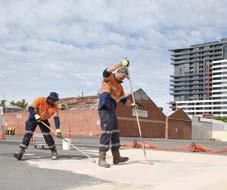
“We encourage pedestrians, cyclists and locals to provide their feedback about the cooling effects of the project by visiting the City of Adelaide website: https://yoursay. cityofadelaide.com.au/cool-road
“The City of Adelaide is also delivering tree planting and water sensitive urban design projects to make the Adelaide CBD a more comfortable place to live and visit.”
Climate KIC CEO Christopher Lee said new innovations in heat reflective products are being used across the globe, with cool roads and cool roofs taking off in America, Europe and in other countries.
“Given South Australia’s climate and relatively high temperatures, these innovations are another way to cool Adelaide’s urban environment and create a more livable city,” said Mr Lee. The Cool Road Adelaide project will be completed at the end of summer. The results will be shared with local councils to help inform future cooling programs across South Australia.
Cool Road Adelaide is a Climate KIC Australia project delivered in partnership with the City of Adelaide ($35,000) and South Australian Government ($50,000), and made possible with in-kind support from Fulton Hogan.
Intermodal Asia 2020 rescheduled to take place in July 2020
Intermodal Asia, which was originally scheduled to be staged in March 2020, will now be held at the SWECC in Shanghai on 14–16 July.
Rob Fisher, Group Director Informa Markets said: “We have been closely following developments since the outbreak of novel coronavirus (COVID-19) in Wuhan in December 2019. First and foremost, our thoughts and support go out to our colleagues, partners and clients in China during this uncertain time.” “After careful consultation with our joint venture partners the China Container Industry Association (CCIA), the in-depth discussion with the venue, we have taken the decision to reschedule this year’s event to ensure the safety of our visitors, exhibitors and staff. By delaying Intermodal Asia, we are providing the container shipping and intermodal sectors time to recover from any setbacks experienced as a consequence of the outbreak and its effect on global trade.”
The postponement has been welcomed by the industry, with Mr Huang Tianhua, President of CCIA, and Vice President of CIMC Group adding: “As a leader within the container shipping industry, CIMC Group’s mission is to promote the development of the global container shipping industry. CIMC has been the main sponsor and a loyal exhibitor of Intermodal Asia since it moved to China in 2014, and Intermodal Asia has become an important stage for CIMC Group to showcase its cutting-edge services, and an opportunity for communication and cooperation with global partners.”
“We greatly appreciate the decision to postpone Intermodal Asia 2020. It reflects the organiser's responsible attitude towards the safety and health of its international exhibitors and visitors, but also reflects confidence in China’s ability to quickly overcome the outbreak.”
“CIMC Group intends to continue fully supporting Intermodal Asia 2020. We also call on international container partners and industry leaders to join Intermodal Asia 2020 to showcase solutions and share knowledge and take this important opportunity to build new business relationships,” Mr Tianhua said.
Intermodal Asia brings together the leading decision-makers and thought leaders in the global intermodal and shipping container sectors. With visitors from more than 90 countries from across the container transport and logistics supply chain, it is the most important annual industry event in Asia. Taking place in Shanghai on 14–16 July, one of the world’s most dynamic logistics markets, Intermodal Asia is a unique opportunity to discover innovative products, services and solutions and meet suppliers, customers and partners to help you gain a long-term competitive advantage and stay abreast of the latest industry developments. It is the perfect opportunity for global professionals to come together to network, do business and encourage the healthy and sustainable development of modern intermodal transport. “We apologise for any disruption to visitor and exhibitor schedules and we trust that the intermodal community understands the reasons behind our decision,” Rob Fisher added. For further information or to secure your free ticket to the event, please visit the Intermodal Asia 2020 website at: www.intermodal-asia.com
Leading Australian traffic management software up for grabs
The rights to a state-owned traffic management system used in many parts of Australia will be sold off to allow the further development of the software and potential international rollout.
Addinsight was developed by the South Australian Transport Department in 2012 and provides real-time and predictive updates on traffic movements and congestion by using beacons installed on the road network to identify movement of devices, including Bluetooth and Wi-Fi.
The Bluetooth sensors were developed and installed across Australia by South Australian company Sage Automation.
In 2016, it was developed into an award-winning app for public use, letting users assess congestion and time delays on their chosen route.
Its creator, former Transport Department engineer James Cox, welcomed the move to commercialise the software.
“I just don’t think the Government’s a good place for software to be commercialised – it’s not geared up for doing marketing and I think that the system’s essentially stagnating being in government, because it’s not being promoted,” he said.
Cox said the software was originally developed as a planning initiative for Adelaide’s North South corridor, but has since moved under the purview of the Traffic Management Centre.
“The system’s essentially just grown and grown,” he said. “At the moment it’s essentially used all over Australia, but it hasn’t really expanded out of Australia, because of that whole word of mouth thing … it needs a bit of investment in trying to get a deal done overseas.”
The South Australian Government recently released an Expression of Interest to the market for the future development of the Addinsight software. South Australia Transport Minister Stephan Knoll said there was an opportunity to “…turbo charge the service AddInsight provides by allowing private sector expertise, capital and creativity to further develop this technology”. “Addinsight is an innovative approach to traffic management and the fact that it is now being used by other traffic management centres across the country is a testament to those involved in its development,” he said. “Addinsight is operating in a dynamic and rapidly emerging market and the state government does not believe taxpayers should continue to fund the development of this technology… there are potential options to use and expand the program into other markets, including logistics or queue management.
“It could also integrate with smart cities or other traffic and planning initiatives, or further synergise with other traffic management products, which should be explored to maximise its use and potential.
“As such, the future of Addinsight technology, software and uses extends far beyond core government business.”
The software captures data that is de-identified, aggregated and utilised by the Traffic Management Centre to monitor and improve traffic flow. Knoll said the Government remained “…open and flexible as to the potential structure of AddInsight through this process” but would “seek conditions that will retain data security provisions as well as guaranteeing continued use of the Addinsight data for the betterment of the state”. “The government will also seek to provide ongoing support to the potential third party by way of enabling the Adelaide network to be used as a test-bed for ongoing enhancements to the software,” he said. “Addinsight will continue to operate as normal and the Government is committed to providing the same level of service that is currently provided to existing customers.”
This story was originally published on news website InDaily.
size of ad .... 88mm x 135 mm AUSSIE GMP WATER CART PUMPS 2", 3" & 4" SEMI TRASH PUMPS CAST IRON VALUE HIGH FLOW HIGH PRESSURE
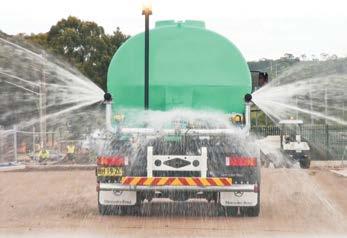
MOVE 2,400 lpm! Semi Trash Pump with... ü 3 YEAR WARRANTY ü FRONT OPENING PORT ü SILICON CARBIDE SEALS ü BIG OPEN IMPELLER ü BARE SHAFT, HYDRAULIC, PETROL OR DIESEL DRIVE
Aussie Pumps
Australian Pump Industries www.aussiepumps.com.au 02 8865 3500 GMP PUMP DEALERS NEAR YOU, AUSTRALIA WIDE


Mobile Media Blasting - Wet & Dry • Specialising in Concrete preparation for Carbon Fibre application • Abrasive & Non Abrasive Blasting • Paint, rust & contaminant removal from many substrates • Line marking removal • Compact machinery for easy access • Low media usage which means less environmental issues with containment and dust • Suitable for confined space blasting Recent Carbon Fibre preparation projects - • The Glen Shopping Centre Mt Waverley • 161 Collins Street Melbourne

NEW YEAR…
NEW RULES


The new rules requiring MASH tested & approved crash cushions came into effect on January 1st, 2020
In accordance with the Austroads / ASBAP ‘Transition to MASH’ process, crash cushions installed on Australian roads are now required to be tested and approved under the AASHTO MASH guidelines, rather than the superseded NCHRP350 guidelines.
Both the SMART CUSHION SC100 and SMART CUSHION SC70 have been successfully tested to MASH-2016 Standards, with both models ASSESSED, APPROVED & RECOMMENDED FOR ACCEPTANCE throughout Australia by ASBAP (Austroads Safety Barrier Assessment Panel).

SMART CUSHION speed dependent crash attenuators have been used in the USA for almost two decades and in Australia for over 5 years – delivering outstanding life-saving performance and significant savings on repair costs in many thousands of impacts.
MASH TESTED & APPROVED
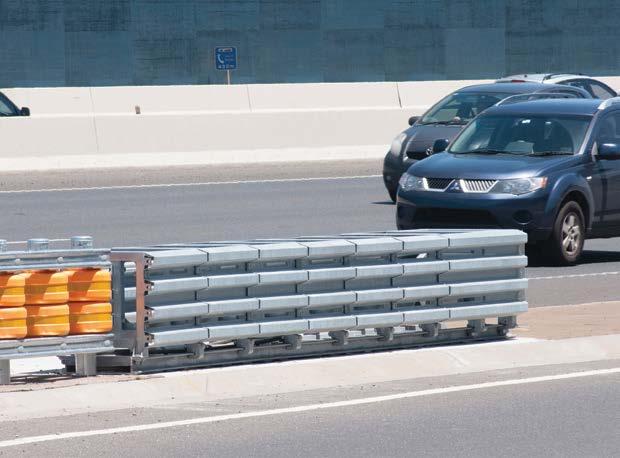
SAVE TIME...

For most impacts up to 100km/h (by vehicles up to 2,270kg) the SMART CUSHION can usually be repaired and reinstated into service in under 60 minutes.
SAVE MONEY...


In 90% of all impacts in Australia, the only spare structural parts needed for repairs are 2 shear pins (COST <$5). After 59 impacts in Australia, the average cost for each reset was $169.
SAVE LIVES...
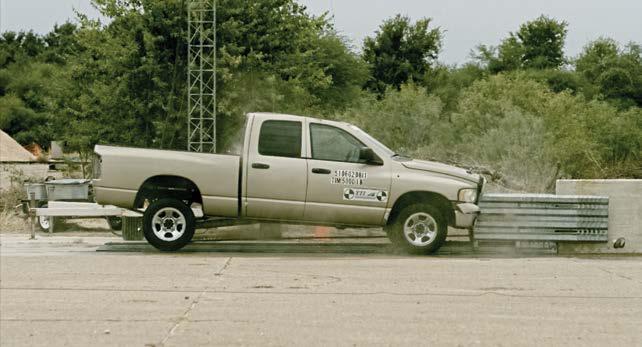
After more than 20 years of successful service internationally and over 5 years successful service in Australia, SMART CUSHION has been directly credited with saving numerous lives and significantly reducing the severity of injuries in literally thousands of impacts.
distributed exclusively by










